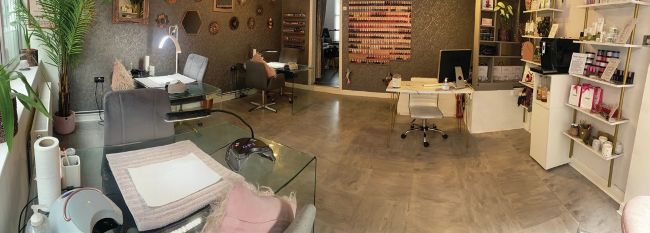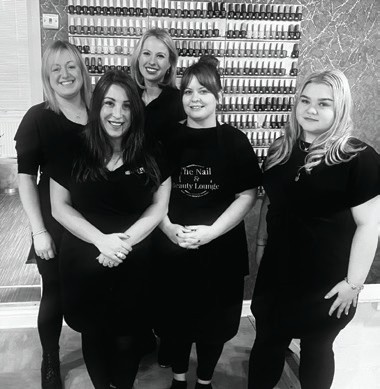BUSINESS MATTERS
Let’s talk about VAT
Is your beauty business nearing the VAT threshold? HELENA BIGGS examines what this means for your pocket & why industry organisations & pros are calling for change
What is VAT?
Value Added Tax (VAT) Is the third largest contributor to public sector finance, behind income tax and National Insurance contributions. It is a way for the government to collect money to pay for public services such as schools, hospitals and roads, and VAT makes up 15% of government revenues.
The threshold
The VAT threshold, also known as the VAT registration threshold, is the amount of money you can earn before you need to register for VAT. This threshold is set on a yearly basis, and tends to increase each year. The UK has one of the highest VAT thresholds in Europe, currently set at £85,000 at a 20% rate. However, this could change in the Spring Budget announcement on 6 March.
If the taxable turnover of your business crosses the VAT threshold, you have 30 days to inform HM Revenue and Customs (HMRC) and register for VAT. You also need to contact HRMC if you expect your turnover to surpass the threshold in the next 30 days, and you must pay HMRC any VAT you owe from the date you are registered.
Once your company has completed its VAT registration, your business will be responsible for:
• Charging VAT on the goods and services you sell to customers.
• Keeping VAT records and a VAT account.
• Paying VAT on the goods or services you buy for your business.
• Submitting VAT returns to HMRC.
“Many beauty business owners make the mistake of looking at their profit, however VAT is based on turnover,” comments a spokesperson from Flawless Beauty Accounting on Instagram. “This is your income before deducting any expenses.
“The threshold is not for a calendar year, tax year or financial year. It is in any rolling 12-month period, so it is important to keep track of your turnover from the past 12 months.
“The standard VAT rate is 20%, so an option is to raise your prices by 20% when you become VAT registered. However, there is a scheme available with a 13% flat rate. If you qualify and get accepted for the Flat Rate Scheme, you pay 13% VAT to HMRC on gross turnover. This means you would not be allowed to claim the VAT on expenses.
“It’s important to consider your options and decide which VAT rate is best for you, which will depend on your business expenses.”
The issue
“The current VAT rate of 20% leads to a cliff edge for businesses at the threshold of £85,000,” comments a spokesperson from the National Hair & Beauty Federation (NHBF). “As there is no gradual increase, many businesses find the transition to VAT registration too challenging: leading to ‘bunching’ where businesses forgo further growth to avoid the abrupt change to the VAT rate.
“This also leads to non-reporting, as small businesses seek to stay below the £85,000 threshold. This can potentially reduce overall economic activity, which in turn leads to reduced tax revenues for the Treasury.”
“With targeted support, we are confident that our sector will continue to make a vital contribution to high streets and community wealth and wellbeing.”
Caroline Larissey
Calls for reform
The NHBF has written to the Chancellor of the Exchequer, Jeremy Hunt, to call for an urgent VAT reform; either reducing the rate of VAT, raising the threshold or introducing a smoothing mechanism or tiered rates around the VAT threshold.
The organisation commissioned an independent paper by strategic consultancy, Pragmatix Advisory, titled Avoiding the cliff edge: considering possible options for a VAT threshold smoothing mechanism, which was published in January. It found that 93% of hair and beauty businesses are below the current VAT threshold.
The report includes case studies from Finland and the Netherlands that show the positive impact of lower VAT rates, revealing: “The Netherlands lowered VAT to 6% in the early 2000s for labour-intensive services, which led to the creation of 4,000 sector jobs.”
It identifies smoothing mechanisms to change the current VAT system to benefit businesses and encourage growth and expansion, namely:
• Options at or above the threshold, meaning reduced VAT revenue for the government:
The report models two options, where graduated VAT could start at £85,000. With a moderately graduated option, HM Treasury would see a loss of £2.5 billion in VAT revenue, counteracted by an additional £2 billion in increased compliance.
• Options starting below the current threshold:
These range from least graduated to most graduated, meaning the government would see no loss in VAT revenue. VAT starting from a lower rate would increase in steps towards the current standard rate of 20%.
Of the proposed reform, Avoiding the cliff edge reports that:
• 86% of hair and beauty businesses support a graduated approach.
• 50% say that a reduction in VAT would be most beneficial for their business.
• 25% believe that raising the VAT registration threshold will help their business.
• 7% feel that lowering the threshold would help their business.
The paper estimates that an additional £25.2 billion in turnover would be declared, returning an additional £2.2 billion in VAT revenue to HM Treasury. At least £33m of this would come from the hair and beauty sector. While the paper estimates an administrative cost for businesses, this would be a small share (2.5%) of average sector labour costs.

Caroline Larissey
Caroline Larissey, NHBF chief executive, comments:
“Ahead of the Spring Budget, we are calling on the government for further targeted sector support in the form of VAT reform. The discussion paper we published, Avoiding the cliff edge, is all about giving the government options for reform in the current climate, including affordable solutions. With targeted support, we are confident that our sector will continue to make a vital contribution to high streets and community wealth and wellbeing.”
The Beauty Accountant shares five ways to make tax less taxing:
1. Set up a simple but effective bookkeeping system.
2. Automate or use technology available, such as online booking systems, receipt capture, online bookkeeping software or an Excel spreadsheet.
3. Review profit and loss on a regular basis.
4. Seek out expert guidance and support on the tax reliefs available to you.
5. Save important dates and information to avoid unnecessary penalties and late filing notices.
www.thebeautyaccountant.co.uk
CASE STUDY: The Nail Lounge, Stourbridge
Loretta Walker, Midlands OPI educator & owner of The Nail Lounge, Stourbridge, shares how VAT registration has impacted her business.
“Due to poor advice from a former accountant, I adjusted my business model in 2019, and this led to The Nail Lounge surpassing the VAT threshold in 2023. Facing this situation for the first time, I had to thoroughly examine pricing, staff hours and turnover, as well as the efficacy of the salon and staff.
“The most daunting aspect was recognising that I needed to raise all treatment prices. A 20% increase across the board seemed impractical. To address this, we shifted to a pricing structure, offering clients the option of a senior or junior therapist. Prices for treatments with junior therapists saw a modest 10% increase, while there was a 15% raise for senior therapists. Some clients were initially hesitant about the adjustments, but we explained the VAT registration situation to them, in order to be transparent.
“Even with a 10% and 15% increase, the desired 20% raise remains elusive. This has left me grappling with VAT payments, impacting day-to-day finances. The 20% VAT rate is particularly testing for a small business like mine in the nail and beauty industry. Unlike sectors with substantial stock purchases, our limited buying means our VAT refunds are never substantial, making it more challenging to balance expenses. Unfortunately, we will need to raise our prices again towards the end of 2024 or in 2025.
“At times, I sense that my hard work doesn’t translate into sufficient earnings. However, with each quarter, I’m gaining insights and striving to keep the salon profitable. Having an accountant who understands the business has been crucial for my financial management. My accountant has provided invaluable support, guiding me through the process, offering insights on staffing and connecting me with other VAT registered salon owners.


“Before VAT registration, I believed my earnings allowed for a comfortable lifestyle. However, now The Nail Lounge is VAT registered, a significant portion of the profit goes to HRMC, leading to financial stress. On a positive note, becoming VAT registered has compelled me to elevate my business operations and is an accomplishment for my business and the salon team, as it shows our growth and success. Staff members now have retail sales and daily work targets, addressing gaps in the diary by offering discounted treatments to clients. The aim is to maximise end-of-basket sales, encompassing both services and retail stock.
“Becoming VAT registered has opened up opportunities for business expansion. The Nail Lounge has introduced new services including hydrofacials, microneedling, radio frequency facials and aesthetics. The ability to invest in high-value machinery for these treatments has been facilitated by the VAT adjustments. I’m committed to pushing forward and further growing my business.
“For a small business, being VAT registered and hovering in the turnover range of £86,000 to £125,000 is considered within ‘the danger zone’. It’s crucial to devise a plan promptly to surpass the £125,000 threshold, and I understand why so many beauty businesses choose to limit growth and remain under the threshold, which is a shame for those businesses, and the industry.”
www.thenaillounge-stourbridge.co.uk
Facebook: /thenailloungestourbridge
Instagram: @the.nail.and.beauty.lounge
HANDY LINKS
• Register for VAT via www.gov.uk
• Check out reports and statements from the NHBF via ww.nhbf.co.uk
• Follow accountants who specialise in working with nail and beauty businesses:
@thebeautyaccountant
@ktsbeautyaccountants
@flawlessbeautyaccounting
@thehairandbeautyaccountants
@beautiful_financials
@soldipartners